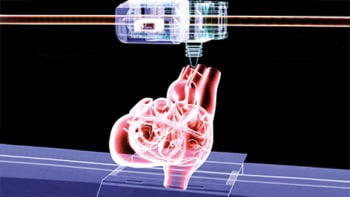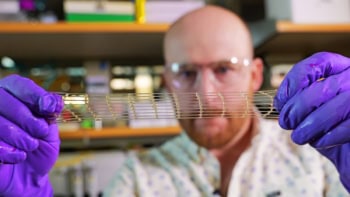
While 3D bioprinting is widely used to construct complex biocompatible structures, researchers are now attempting to extend the technique into the fourth dimension. Here, 3D printed objects can be made to “self-transform” over time, which means that they can take on different forms or functions when exposed to physical stimuli such as osmotic pressure, heat, current UV light or other energy sources.
Researchers in the US have now shown that they can fabricated 4D hierarchical micropatterns by exploiting natural soybean oil as the bioink material. The work, which is published in Biofabrication, describes how the micropatterns can be used as biocompatible, shape-changing scaffolds for use in tissue engineering and regeneration applications (Biofabrication 10 035007).
“We used smart natural lipids, that is, soybean epoxidized acrylate (SOEA), as an ink material to fabricate biocompatible, topographical and 4D dynamic shape-changing tissue scaffolds,” says team leader Lijie Grace Zhang of The George Washington University in the US.
Such 4D materials have already been demonstrated in other fields. One of the best-known examples are shape-memory alloys, in which a change in temperature triggers a change in shape of the alloy. Although still in its infancy for tissue engineering applications, 4D printing may ultimately allow for tissue transplants that better mimic biological tissues and organs, which are highly organized and contain structurally anisotropic components.
This structural organization affects the way the cells arrange themselves in a biological structure, since they respond to “cues” that depend on the biostructure’s surface topography. Although researchers have developed many techniques to manufacture nano- and microstructures that can regulate the behaviour of cells, it is still difficult to fabricate biomimetic tissue scaffolds that respond to topographical cues in the same way as their natural counterparts.
Complex surface micropatterns
What’s needed, says Zhang, is a technique that generates surface structures on a macro-architecture. “The technique we employed, photolithographic-stereolithographic-tandem strategy (PSTS), relies on sequentially treating the same ink feedstock with photolithography and stereolithography,” she says.

The team used SOEA as the ink material, which is derived from soybean oil – a natural, renewable source that has been attracting much attention as a biomaterial in recent years. “We were able to make a 10 micron-thick liquid SOEA film in a matter of seconds using the photolithography step,” says Zhang. ”This film then further solidifies after stereolithography to generate complex surface micropatterns, thanks to a layer-by-layer process.”
Shape-shifting constructs
The fabricated scaffolds can change shape when stimulated by an external trigger, which means that they can better mimic natural biostructures that adapt to their morphology. The subtle surface patterns could also be used to regulate the behaviour of human stem cells, such as human bone-marrow mesenchymal stem cells (hMSC). “The images that we obtained and analysed (using National Institute of Health software) show that hMSCs actively grow and highly align along the micropatterns, forming an uninterrupted cellular sheet,” Zhang told Physics World.
As a proof of concept, the researchers made a 4D patch for regenerating heart cells that showed significant growth of heart tissue – as confirmed by immunofluorescence staining and a technique called qRT-PCR analysis. “This study shows the great potential of these smart patching scaffolds as implantable materials for future tissue and organ regeneration,” says Zhang.
The team, which includes scientists from the University of Maryland in Baltimore, says that it is now planning to 4D bioprint light-sensitive smart biomaterials and reprogrammable architectures for use in heart regeneration and bionanorobot applications.
- Read our special collection “Frontiers in biofabrication” to learn more about the latest advances in tissue engineering. This article is one of a series of reports highlighting high-impact research published in the IOP Publishing journal Biofabrication.



